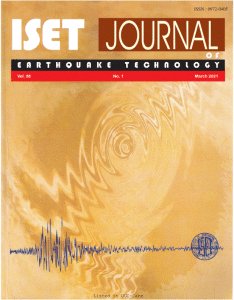Home > Issues & Journals
SEISMOTECTONICS AND SEISMIC HAZARD OF GERMANY IN THE EUROPEAN CONTEXT
BORMANN P
Paper No.: 340
|
Vol.: 31
|
No.: 2
|
June, 1994
|
pp. 55-89

Abstract
Although Central Europe is a rather stable continental platform area it is not void of seismic activity. Its crust has mainly been consolidated and internally structured by Hercynian folding and subsequent block-faulting in connection with the collision of Africa and Europe and the related Alpine orogeny in the south. Dominating later fault tectonic features in Germany are the Upper and Lower Rhinegraben in the west and the Hercynian striking Franconian Line and the Central German Main faults in the center and the east, respectively, as well as several N-NNE striking, obviously older and deeper rooted fault zones both on the Franconian platform in the southwest (the 9°-E zone) and in northeast Germany (12°-E zone). The seismic activity is related to this structural inventory and more or less concentrated in some shear-zones which are currently active under the recent orientation of the stress field in Central Europe. Focal mechanisms are chiefly horizontai strike-slip and normal faulting. Composition and heat flow controiled crustal rheology limit the focal depth to a maximum of about 22 km, no.mally between about 5 and 15 km. The Benioff-graphs of the various active regions in Germany show generally episodes of increased and reduced activity with different time constants and patterns hinting to different stress loading and relaxation histories and related crustal rheologies. Geodetically determined recent crustal movements, young tectonic deformations and the history of earthquake activity in Germany make it unlikely that events with magnitudes above 6 and epicentral intensities above 8.5° MSK will occur. The largest mining induced seismic events in Germany were almost of the same order. The paper discusses the seismic activity and its peculiarities in the main seismic regions of Germany, the unique swarm earthquakes in the Vogtland/Westerm Bohemia in particular.
Damages incurred in connection with the strongest tectonic earthquakes in recent years, i.e. the 1978 earthquake in the Swabian Alb and the Roermond earthquake of 1992 near the German-Dutch border, are compared with that of the probably strongest mininginduced event in the history of mankind in 1989 at Völkershausen (M = 5.5; 1max = 9° MSK). The current German hazard maps as derived by various authors both on the basis of probabilistic considerations and actual repeated macroseismic observations are shown and related to the seismic zoning and building regulations which are currently applied.
Keywords: Not Available
©2025. ISET. All Rights Reserved.